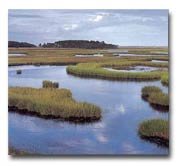About Coastal Areas
EPA's study of ecosystem management of coastal areas adaption relevance to climate change includes the results of the study of the following projects:
Coral Reef Adaptation: EPA utilized the Adaptation Design Tool for the coral reef adaptation project to provide valued ecosystem services such as fisheries, coastal protection, and tourism with a plan when these are threatened by the effects of increased sea surface temperatures, sea level rise, and intensifying storms.

- Delaware Bay Wetland: Coastal salt marshes - which provide valued ecosystem services such as flood control, water purification and critical habitat - are vulnerable to ongoing sea level rise, which is interacting with physical and biological attributes of the system to induce complex changes in salt marsh habitats.
- Sea-level rise: Adaptation professionals and others interested in understanding sea-level-rise vulnerability in coastal areas can use EPA's SEA Tool to understand potential impacts of sea-level rise and provide valuable data for coastal planning, infrastructure development, and risk management. The user-friendly nature of the tool provides clear and specific data for varied sea-level-rise scenarios to help ensure that users can easily access the data, investigate scenarios most relevant for them, and accurately and effectively incorporate outputs into decision making.

